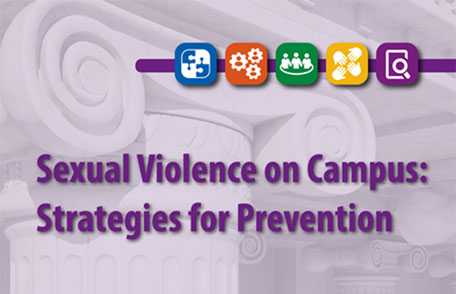Preventing Sexual Violence
 Prevent sexual violence on college campuses.
Prevent sexual violence on college campuses.
Preventing sexual violence (SV) of all types requires a shift in culture and climate. Primary prevention—preventing violence before it occurs—is difficult work and change takes time. Culture change doesn’t happen overnight, but it does happen. To address this problem, the White House established the Task Force to Protect Students From Sexual Assault in 2014. The task force had a mandate to strengthen federal enforcement efforts and to provide schools with additional tools to help prevent SV on their campuses.
CDC convened two meetings in 2015 at the request of the task force. The first was a think tank that included more than 30 subject matter experts who participated in a working meeting to identify prevention policies and programs currently being implemented on U.S. campuses. Key constituencies included prevention practitioners, college and university administrators, prevention educators, students, researchers, law enforcement, CDC’s Rape Prevention and Education (RPE) grantees, federal partners, and representatives from SV resource centers. The second action planning meeting convened CDC’s RPE grantees and their state teams to use the think tank findings to guide the development of multi-year actionable plans to prevent SV on campuses.

The five components of campus sexual violence prevention.
Sexual Violence on Campus: Strategies for Prevention
Sexual Violence on Campus: Strategies for Prevention [3.52 MB] combines the findings from the think tank and action planning meetings with the best available evidence on SV prevention and reflects CDC’s current thinking about how to prevent SV on college and university campuses. This document includes examples of strategies from CDC’s STOP SV: A Technical Package to Prevent Sexual Violence [2.85 MB] and is a starting place for SV practitioners and their campus partners to begin planning for and implementing SV prevention strategies in a college or university setting.
A Framework for Campus Sexual Violence Prevention Efforts
Five components represent the framework for CDC’s approach to campus SV prevention efforts. The integration of all five components offers an opportunity to implement prevention efforts that have greater impact on reducing and preventing SV on campus.
The components include:
- Comprehensive Prevention: strategies and approaches that complement and reinforce one another across the social ecological model.
- Infrastructure: the basic organizational systems and structures needed to effectively implement SV prevention strategies on a college or university campus.
- Audience: the recipients and observers of the prevention messages, campaigns, or strategies.
- Partnerships and Sustainability: developing healthy working relationships with community stakeholders and partners to strengthen, coordinate, and align prevention efforts that are more sustainable for them over time.
- Evaluation: essential public health practice that identifies what is working and what is not working with the programs, policies, or practices.
- Page last reviewed: December 5, 2016
- Page last updated: December 5, 2016
- Content source:
- National Center for Injury Prevention and Control, Division of Violence Prevention
- Page maintained by: Office of the Associate Director for Communication, Digital Media Branch, Division of Public Affairs




 ShareCompartir
ShareCompartir